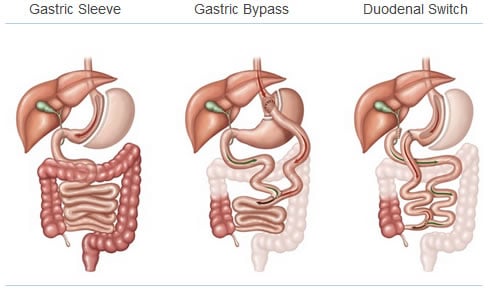The duodenal switch is a combination of the gastric sleeve and the gastric bypass. The biliopancreatic diversion with duodenal switch, commonly referred to as the duodenal switch (DS), statistically has the best overall weight loss results despite the frequency at which it is performed. On average, patients routinely lose 80% of their excess weight and in many cases, closer to 100%.
So if the duodenal switch has the best overall weight loss results, then why doesn’t everybody have this procedure? Most bariatric surgeons will tend to reserve the duodenal switch for heavier patients who need to maximize their weight loss (BMI of 50+). Below, I will also explain a few other reasons why patients may choose different procedures over the DS.
How the Duodenal Switch Works
In performing the duodenal switch, the surgeon creates a gastric sleeve and additionally will divide the duodenum, which is the first part of the small intestine. The surgeon then identifies the end of the small intestine were it is attached to the colon, measures about 5 feet back and makes a mark. The surgeon measures back another 5 feet or so, at about 10 feet from the colon, and divides the small bowel. This part of the small intestine where the division occurs is reconnected to the duodenum/stomach and also the small bowel is reconnected to establish intestinal continuity about 5 feet from the colon.
Ultimately, the duodenal switch removes part of the stomach and significantly shortens the small bowel from a digestive/absorptive standpoint. This results in smaller portions of food consumed and faster movement of those portions through your digestion system.
The duodenal switch works to create a small stomach, essentially a gastric sleeve, about the size of a banana, that is then connected directly to the lower 1/3 of of the small intestine (ileum). As a result, the rest of the upper portion of the small intestine (duodenum and jejunum) is bypassed.
More specifically, in this altered anatomy, food travels down the “new” portion of the stomach and enters the small intestinal segment called the ileum (the alimentary/enteric limb). Digestive juices are then released from the liver and the pancreas, traveling down the pancreaticobiliary limb. The food and the digestive juices meet about 5 feet from the colon and are absorbed within the common channel.
 In a similar manner to the gastric bypass, the small intestine is also shortened in the DS (however much shorter then the bypass), therefore there is less absorption of nutrients. Duodenal switch patients may experience greater changes in mineral deficiencies and bowel function compared to a gastric bypass patient. Therefore it is extremely important for these patients to get adequate nutritional intake in the form of protein and nutritional supplements to ensure they are receiving the appropriate amount of vitamins and minerals to sustain a healthy lifestyle.
In a similar manner to the gastric bypass, the small intestine is also shortened in the DS (however much shorter then the bypass), therefore there is less absorption of nutrients. Duodenal switch patients may experience greater changes in mineral deficiencies and bowel function compared to a gastric bypass patient. Therefore it is extremely important for these patients to get adequate nutritional intake in the form of protein and nutritional supplements to ensure they are receiving the appropriate amount of vitamins and minerals to sustain a healthy lifestyle.
Unlike the gastric bypass, which the small intestine is shortened by about 25 – 30%, the duodenal switch bypasses in excess of 75% of the small intestines absorptive capacity. As a result of this, the duodenal switch is considered a malabsorptive operation, which makes the likelihood of nutritional deficiencies and changes in bowel function much higher. Because of these extreme alterations to the body’s method of digestion, our practice mostly reserves the duodenal switch for our patients who have a much higher body mass index, usually 55 or higher. Although this operation can be performed on lower body mass indexes, patients who have the sleeve gastrectomy or the gastric bypass can still expect a significant amount of weight loss with a lower nutritional risk.
How the Duodenal Switch Helps with Weight Loss
Traditionally, surgeons would claim that weight loss surgery was effective because it resulted in eating less (restriction) and absorbing fewer calories (malabsorption). Although this is true, there are more important mechanisms as to why patients lose weight following bariatric surgeries.
Based on current research, physicians and educators believe that weight loss as a part of a duodenal switch and gastric bypass surgery is a result of bypassing the duodenum coupled with changes in a patient’s hormone levels. Indirect evidence of these hormonal changes has been recorded as a result of most gastric bypass patients with diabetes now having normal glucose control (cure of the diabetes) prior to even losing weight.
To learn more about the duodenal switch or other bariatric procedures, watch our free online seminar or schedule a consultation with our bariatric team.


